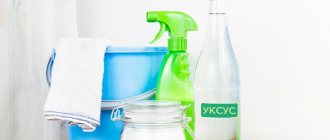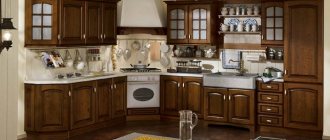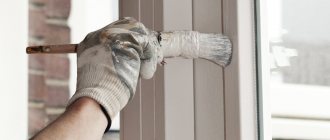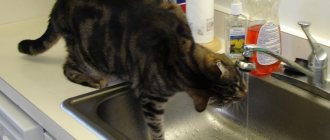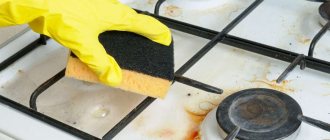The use of plastic is becoming increasingly widespread; it is involved in almost all spheres of human life. Look around you and try to find at least a small area in your apartment where there is no plastic. Plastic panels are also becoming popular, and this is facilitated by the fact that they are easy to care for and look very decent.
In addition, this material is affordable. We will try to figure out what is the best way to wash plastic. But before you find out how to wash plastic panels, it would not hurt you to find out what they are and what properties this material has.
Required Tools
To wash plastic from nicotine deposits, grease, dust and other contaminants, you need to use only soft, gentle products and tools.
To care for plastic panels you will need:
- rubber spatula/hard brush (for processing seams);
- latex gloves;
- ladder;
- sponge (foam rubber or melamine);
- a rag made of cotton or other soft fabric;
- mop with sponge (for washing ceilings and other hard-to-reach places).
Attention! To preserve plastic products for as long as possible, it is recommended to use self-prepared cleaning solutions.
Eliminate and neutralize
Based on the above reasons, you can draw conclusions and make your life and ceiling cleaning easier by eliminating the causes of stains and stains.
- Mosquito nets protect against insects;
- Forced hoods help reduce condensation levels;
- A kitchen hood minimizes the deposition of grease and oil on the ceiling;
- High-quality and well-done repairs help to avoid unpleasant consequences.
Available means
You can wash away stains, grease, mold, and other contaminants from plastic panels using cheap inexpensive cleaners that are available in every home. It's much cheaper than buying household chemicals in a store.
Soap
Plastic panels can be washed with soapy water, which works well even with old stains and plaque. Suitable for both cosmetic and laundry soap.
Method No. 1:
- Grate a piece of soap and place it in a deep container.
- Add dish soap.
- Pour a liter of warm water into the mixture and mix everything thoroughly.
- Soak a sponge or piece of cloth in the solution and wash the panels until the dirt disappears.
Method number 2:
- In a bowl, grated soap must be mixed with 1.5 liters of water.
- Add 1 tsp to the solution. alcohol, citric acid, mix well.
- Moisten a soft cloth in the prepared liquid and wash the dirty panels. Then the treated surface must be wiped with clean water and dried with napkins or a towel.
Soda
Plastic panels can be washed with a soda solution. It cleans PVC materials well and effectively removes nicotine deposits and grease. It's best to only use baking soda to soak dirty stains, as scrubbing may scratch the surface.
The solution is very easy to make, just mix water with 2 tbsp. l. soda You should get a paste that is applied to the contaminated area. It should be left for 2-3 hours, then washed off with a damp cloth. Wipe plastic panels with a dry towel.
Vinegar + vodka
Vinegar and vodka are used to clean plain plastic sheets. Colored or decorated surfaces should not be washed with these liquids; they can erase the design and discolor the coating.
Before use, it is necessary to treat an inconspicuous area of the plastic product with this mixture and monitor the reaction of the material. If everything is in order, treat the entire surface. To clean plastic, soak a sponge in vodka, then in vinegar. Wash the plastic product with water and dry with a dry cloth. Don't forget to use gloves.
Ammonia
Ammonia is good for cleaning plastic surfaces from dirt of various origins and giving them a beautiful shine. Mix 1 liter of water and 1 tbsp. l. ammonia. Soak a lint-free cloth in the liquid to remove any build-up or stains. Finally, wipe the plastic dry.
Bleach
Bleach will help remove yellowed deposits and greasy stains on plastic panels. You need to use it with rubber gloves; with prolonged exposure it burns the skin, causes irritation and dryness. 1 cap of whiteness is diluted in 5 liters of water. Soak a cloth in the liquid and wash the surface evenly to avoid streaks.
Melamine sponge
The melamine sponge is a real lifesaver even with difficult-to-remove stains. It is easy to wash off not only stains and grease stains, but also lime, felt-tip pens, ink, and paints. It is enough to moisten the sponge in water and wash the problem areas until the dirt is removed.
Attention! It is not recommended to use this cleaning method on surfaces in contact with food. Melamine is dangerous if ingested.
Household chemicals
Plastic panels can only be washed with liquid, gel or cream cleaners. No powders, acids, solvents, etc. cannot be used, they spoil the material. Detergents can be universal and specialized. The latter are often more expensive and cannot be found in every store. Universal cleaners are sold in all departments of household chemicals. They are quite practical, as they are designed for different types of surfaces.
Popular means for cleaning plastic panels are:
- Cif Cream. Convenient, delicate creamy product for cleaning plastic surfaces. Cleans grease and limescale well. A rag should be moistened with a small amount of Cif and the contaminated areas should be washed. If the stains are old, the cream should be left for 15 minutes for a more effective effect;
- Mr. Muscle, Mr. Proper perfectly cleans plastic panels and even corrodes old grease. These cleaning liquids are safe for the surface, do not leave streaks, and do not require rinsing. To wash plastic, you need to purchase universal products;
- The “LOC” cleaner from the Amway brand carefully cares for any materials and removes mold and greasy stains well. Safe composition, does not cause allergies or irritation. The product in a volume of 35 ml should be diluted in 5 liters of water, moisten a cloth with it and wash the PVC panels. There is no need to rinse it off with water;
- Glorix. The cleaner is available in spray form. Effectively copes with mold and disinfects surfaces. For best results, the composition should be sprayed onto the panel and left for half an hour, then rinsed with water.
Attention! Household chemicals are suitable for processing laminated panels; the matte finish can be cleaned using the dry method using a vacuum cleaner.
Household chemicals
Not everyone trusts traditional methods of cleaning panels, and in some cases these means may be powerless. If you have exhausted all the possibilities, or if you simply don’t want to bother with making your own detergents, then it’s time for you to go to a household chemicals store and find a suitable product for your panels.
Carefully read everything that is written, and not only on the front side of the bottle, but also on the back - what is written in small letters. Usually, this is where all the most important information about the product is located. Its composition, how it is used and for what materials. As already written from the very beginning, it is better to avoid powders, because even with careful use, the powder can leave initially invisible scratches that will appear after some time.
For plastic panels, both laminated and matte, the most suitable are gels, liquid-like substances containing chemically active substances that quickly remove any type of contamination. It is best to leave your choice to world-famous brands. In some cases, savings are not needed; if you buy a cheaper product made by someone unknown, you may not only fail to cope with the stains, but also cause harm to the panels.
How to wash plastic panels in the bathroom?
The bathroom is a room with high humidity, where limescale, mold, rust, and fungal microorganisms often accumulate. Therefore, it requires regular cleaning and ventilation to avoid these troubles. You should also check the plumbing and pipes to replace them if necessary. Rusty pipes are the main cause of fungal formations, mold and yellow discoloration.
It is recommended to wash plastic walls in the bathroom with cleaners in the form of gel, cream, or paste. Cleaning should be done with soft sponges (acrylic, foam rubber) and cotton cloths. Mold can be easily washed off with chlorine-containing liquids. Bleach works great for removing rust. Residue from tobacco smoke, dirty splashes can be washed off with a simple soapy liquid. To prevent complex stains, it is important to regularly care for plastic. You can wipe it with ammonia or soda paste twice a month. After treating plastic materials with detergents, they should be thoroughly wiped dry.
Using Melamine Sponge
Melamine is a porous material that has weak but effective abrasive properties. Thanks to this, it captures dirt, including very persistent ones, but does not scratch the coating of plastic panels. Melamine is simply softer than PVC or other materials used for lamination.
When washing with a melamine sponge, it is not necessary to use third-party cleaning agents:
- Cut a small piece of eraser from the melamine sponge. Or you can use it all, but then you need to throw it away;
- Lightly wet and wring out the melamine sponge;
- Move it across the panels using wide, even movements from top to bottom (or left to right, but also moving from top to bottom);
- Wipe dry.
The main advantage of a melamine sponge is that it can remove even such “heavy” stains as pencil drawings or traces of cosmetics.
How to wash plastic panels in the kitchen?
The kitchen is a place where fat, dirt, soot, nicotine deposits, food traces and other contaminants accumulate. The cooking area, the area near the sink and the ceilings get dirty especially quickly. Fat can be washed off well with a soap mixture with the addition of citric acid and alcohol, and soda paste. For severe contamination, you can use store-bought household chemicals.
To clean kitchen plastic panels you need to:
- Clear your workspace (take down paintings, put away dishes, etc.).
- Prepare a container with cleaning solution, sponges, rags, and a spatula. Wear rubber gloves and, if necessary, a protective mask against toxic fumes.
- Before wet cleaning, use a rubber spatula or a hard brush to remove grease from all seams and hard-to-reach places.
- If there are areas with old dirt, they need to be soaked with cleaners for a short time.
- After completing the above procedures, wet cleaning of the panels is carried out. Then the surfaces are washed with water and wiped dry.
Attention! The water used to prepare solutions and wash plastic should be warm, but not hot or cold. The optimal temperature is 30-40 degrees.
Sequence of work
Usually everyone is interested in how to clean the ceiling and in what order it should be done. Work on cleaning the ceiling from dirt should be carried out in the following sequence:
If the ceiling has been subjected to severe contamination, which has left deposits on its surface facing the ceiling, then this problem can be solved by dismantling the entire structure. In this case:
- the ceiling is dismantled;
- each panel is individually washed and wiped dry;
- the frame and floor slab are cleaned;
- the ceiling is installed in its place.
By following these simple recommendations, you can keep your ceiling clean and tidy. Also read: Plastic ceilings in the kitchen.
[custom_ads_shortcode1]
How to wash a ceiling made of plastic panels?
To wash the ceiling panels, you will need a stepladder, a sponge, a rag, gloves, and detergent. Yellow plaque and grease often accumulate at the top, so it is effective to treat the ceiling surface with vinegar and vodka, ammonia or soda.
If there are no stubborn dirt on the ceiling, and you need to do a light wet cleaning, you can use a mop with a soft sponge at the end. A mop is not suitable for removing grease, yellowness, and old stains. They must be cleaned manually with a sponge or cloth.
You can wash PVC ceiling panels as follows:
- Apply cleaner to difficult-to-remove ceiling stains and leave for 20 minutes.
- Then use a sponge soaked in the prepared solution to rinse all the panels thoroughly. If the ceilings are yellow, then it is recommended to use bleach diluted in water (2 tablespoons per 5 liters).
- After cleaning the plastic, wipe it dry with a soft towel or other cloth.
Advice! If you are planning a general cleaning of the entire room, then it should begin with washing the ceiling. A small amount of water or foam will drip from it, contaminating other areas of the room.
Preventive actions
Elimination of the listed problem situations involves the following actions:
- installation of forced hoods, which prevents the formation of condensation
- Minimizing fat and oil deposits using a range hood
- timely repair of roofs, pipes, taps
- regular wet cleaning of the premises to prevent dust from settling
- mosquito nets on windows to prevent insects from entering
[custom_ads_shortcode2]
Complex contaminants
In addition to the usual stains of grease and dirt, there are also complex stains on plastic panels that are difficult to deal with ordinary detergents. These include residual sealant, marker, ink, severe rust, and brilliant green. They are more difficult to remove, but still possible.
Rust and limescale
Rust on a plastic panel is usually formed from corrosion of old pipes. Limescale deposits occur in the bathroom due to exposure to hard water. You can get rid of these contaminants by the following means:
- acetic acid;
- hydrochloric acid;
- a mixture of ammonia and peroxide (1:10);
- lemon juice;
- "Domestos";
- universal cleaner "Mr. Muscle."
Attention! Rust and lime cannot be removed from plastic with iron scrapers, hard brushes, acetone, or caustic chemicals.
Tobacco smoke
In rooms where people smoke, plastic panels quickly become yellow and have an unpleasant odor. If you don’t clean them for a long time, then it will be very difficult to get rid of nicotine deposits. Traces of cigarette smoke from surfaces can be washed in several ways:
- Prepare a mixture of 50 ml of white and 10 liters of water. Moisten a soft cloth with it and wipe the plastic evenly, in one direction, so that there are no streaks left.
- If the plastic panel is plain, has no patterns and is not made in bright colors, it can be washed from tobacco smoke using vinegar and vodka. You need to moisten a foam sponge in the prepared solution and carefully wipe the yellowed areas with it. After processing, the plastic should be rinsed with water and dried.
- The easiest way to remove nicotine from plastic panels is to use a melamine sponge. It needs to be moistened with water and wiped off the problem areas.
- You can also wash plastic from tobacco deposits with soapy water. It should be prepared from water and grated soap with a low alkali content. Moisten a rag with the resulting liquid and wipe the dirty area.
Zelenka
The green stuff is quite difficult to remove. A regular cleaner does not always cope with such stains, especially old ones. If the plastic is white and plain, then it can be washed with a chlorine-containing substance in a matter of seconds.
If the plastic panel is colored, then a fresh stain from the green paint can be removed with washing powder, soap solution, kerosene or gasoline. The last two liquids should be used in minimal quantities in a well-ventilated area. If there are children or animals in the house, then gasoline and kerosene are not recommended.
Sealant
Traces of sealant on the plastic are washed with a solution of ammonia. It is necessary to dilute 20 ml of ammonia in water (1 liter) and treat problem areas with this liquid. Next, you need to rinse the plastic with water and dry it.
Markers
When there are children in the family, housewives often have to struggle with children's works of art on the walls and furniture. Felt pens, markers and even pens can be washed well with sulfur matches. To do this you need:
- Remove sulfur from several matches and soak it in a small amount of water for 15 minutes. It should turn into mush.
- The prepared product should be applied to the painted area of plastic and left for 10 minutes.
- Rinse off any remaining paste with water and wipe the plastic dry.
Plastic panels are an undemanding, weather-resistant material that is easy to care for. It is enough to wipe its surface at least once a month with detergent. If contamination appears, then it is quite possible to deal with it using improvised means.
Details
Folk remedies
Soap
A soap solution will help remove various contaminants from plastic panels, including old stains and plaque. You can use any soap - laundry or cosmetic.
- grate a piece of soap and put it in a container;
- add dish gel there;
- mix everything with a liter of warm water;
- Place a sponge in the prepared solution and wash the panels until the dirt disappears.
- mix crushed soap and 1.5 liters of water;
- add 1 tsp to the soap solution. citric acid and 1 tsp. alcohol;
— moisten a soft cloth in this solution and wash the panels from dirt.
Soda
A soda solution will help wash plastic panels from grease and cigarette residue. To do this, you need to make a paste-like mixture from baking soda and water and apply it to the contaminated areas. Leave the panels like this for 2 - 3 hours, then rinse with a damp cloth and wipe with a dry towel.
Vodka and vinegar
A mixture of these products can be used to clean plastic sheets of the same tone. If the panels are multi-colored, then this product cannot be used, because it can ruin the design.
To begin with, it is better to test such a product on an inconspicuous area and watch its reaction. If nothing bad happens, then you can use it on the entire surface. To do this, soak the sponge first in vodka and then in vinegar and wash the plastic products. Finally, you need to rinse the panels with water and then dry them. When using this product, your hands must be protected with rubber gloves.
Ammonia
This product perfectly washes dirt from plastic panels and with its help they get a beautiful shine. To do this, 1 tablespoon of ammonia is mixed with 1 liter of water. Moisten a cloth in the prepared solution and wash off stains or plaque with it.
Bleach
Bleach is often used to clean yellowed fabrics and remove grease stains. These products can burn the skin, so be sure to protect your hands with rubber gloves. You will need to dissolve 1 cap of bleach or other bleach in 5 liters of water. Moisten a rag in the prepared mixture and apply evenly to the surface.
Melamine sponge
The melamine sponge is a real lifesaver for stubborn stains. It easily washes not only grease stains and stains, but also felt-tip pens, paints, lime, and ink. You just need to wet the sponge with plain water and wash the stain until it is removed.
REFERENCE! Melamine is dangerous if ingested, so using such sponges on surfaces in contact with food is not recommended.
Household chemicals
For plastic panels, you can use only liquid products, or products in the form of gels and creams. Acids, powders, solvents, and other aggressive agents cannot be used, as they will damage the material. The most common means are:
How to clean plastic panels...
...in the toilet and bathroom
The bathroom is a room with high humidity, where mold, limescale, rust, and various fungal microorganisms often accumulate. For this reason, baths need to be constantly cleaned and ventilated to avoid various troubles.
If there are plastic panels in the bathroom, they should be washed with products in the form of gel, paste, or cream. Cleaning sponges should be soft and fabrics should be cotton. Chlorine products are good for cleaning mold from panels. Bleach will save you from rust. A regular soap solution will save you from nicotine deposits and splashes of dirt. After cleaning the plastic panels, they should be thoroughly wiped dry.
Cleaning plastic panels in the kitchen
The kitchen is a place in the house where grease, soot, dirt, nicotine deposits, food marks and other contaminants accumulate. The cooking area, the area near the sink and the ceilings are especially affected.
REFERENCE! If the contamination is too strong, then it is better to use household chemicals purchased in the store.
How to clean plastic panels on the ceiling
To do this, you need to find a stepladder, rags, gloves, sponges, and detergents. Grease and yellow plaque often accumulate on top, so it is best to treat the ceiling with vodka and vinegar, soda or ammonia.
If the ceiling is almost clean and you just want to freshen it up, you can use a mop with a foam sponge.
REFERENCE! To clean yellow stains and grease, a mop will not be enough; such stains must be cleaned manually with a rag or sponge.
Cleaning panels from complex contaminants
In addition to ordinary dirt and grease, complex stains can also form on plastic panels that are not affected by ordinary products. This could be brilliant green, ink, markers, rust, sealant. It is difficult to remove them, but it is possible.
Limescale and rust
Most often, rust appears on plastic panels due to the presence of old pipes. Limescale deposits occur because the panels are constantly exposed to hard water. Such contaminants can be removed by the following means:
- a mixture of peroxide and ammonia 50/50;
How to clean plastic panels from tobacco smoke
In rooms where people smoke, plastic panels quickly develop an unpleasant odor and yellow discoloration. If you don’t clean them for a long time, it will be very difficult to remove nicotine deposits later. But it is possible, and this is done in the following ways:
Zelenka
Green stains are very difficult to remove. Ordinary cleaners often fail to remove such stains, especially old ones.
REFERENCE! If the plastic is white, then you can easily wash the brilliant green with white.
If the panel is multi-colored, then a fresh stain can be removed with washing powder, soap solution, gasoline or kerosene.
How to remove silicone sealant from plastic panels
Ammonia will help remove traces of sealant on plastic panels. You need to dissolve 20 milliliters of ammonia in 1 liter of water and treat the contaminated areas with the resulting solution. The plastic is then washed with water and dried.
Markers
If children have stains from felt-tip pens, markers or even pens on plastic panels, then matches, or rather sulfur from them, will come in handy. For this:
Plastic panels are undemanding and resistant to external influences materials, which are quite easy to care for. You only need to occasionally wipe their surfaces with detergent (at least once a month). When contamination appears, it is quite easy to deal with it using the folk remedies described in this article.
Using soda
Baking soda is used to remove spot stains. Therefore, the panels must first be washed with water or household chemicals as usual. And wipe them dry, of course.
Then you can work with individual spots:
- Prepare a thick paste from baking soda. To do this, take a certain amount of powder and add warm water to it until you get the consistency of rich sour cream;
- Apply the paste to the stain and leave for 30 minutes;
- Rinse off the paste with plenty of water and wipe the panels dry.
- You cannot rub soda paste over the surface of the panels. It has an abrasive effect, which can cause the surface of the material to become scratched.
Tips for washing PVC surfaces
In order not to turn your apartment into a bunch of chemicals, and cleaning does not turn into torture, follow some tips:
- Wipe the panels regularly with soapy water or glass cleaning spray;
- After water manipulations, ventilate the bathroom;
- After taking a shower, be sure to wipe the PVC surface from any soap residue;
- Following these simple rules will allow you to significantly reduce the time spent on general cleaning.
Necessary equipment
- Cleanser;
- soft textured rags;
- soft acrylic sponges;
- foam sponges.
When cleaning plastic PVC panels, it is necessary to take into account their type: glossy or matte. The chosen detergent and method depend on this. Glossy ones are more popular in use, as they can withstand more active dry cleaning. This method is contraindicated for matte finishes, as the pattern or brightness of the colors may subsequently be lost. Matte PVC panels are also more susceptible to contamination and must be cleaned exclusively using the dry method or using a vacuum cleaner.

